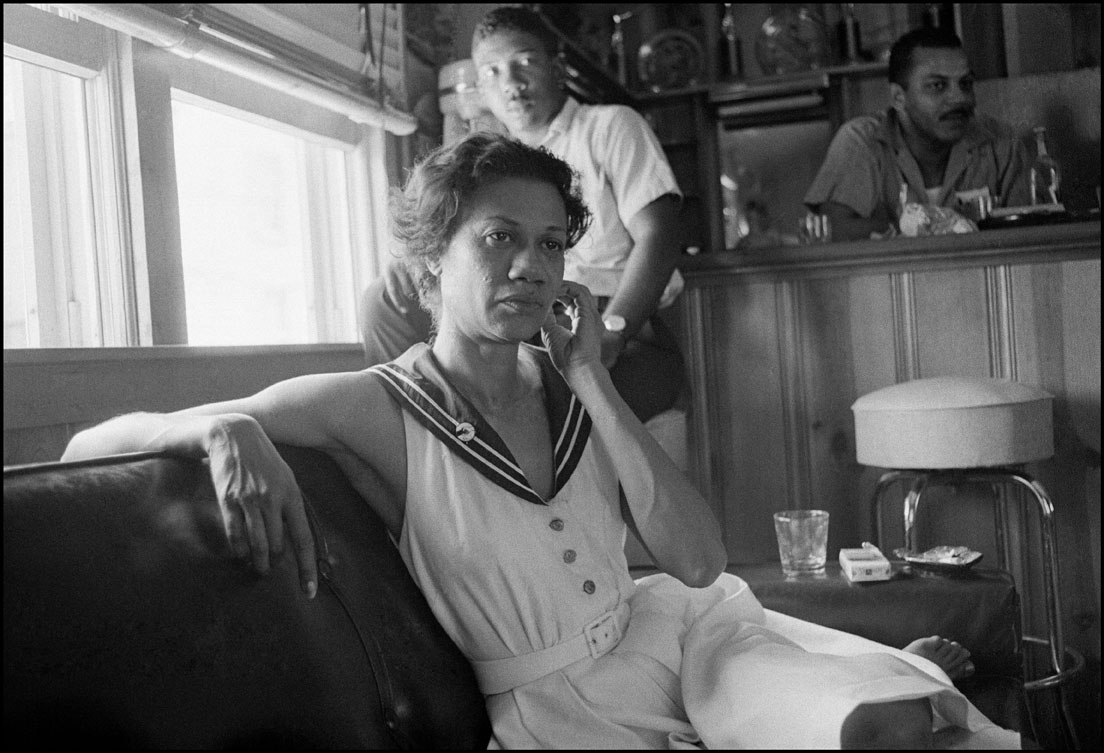Gloria Richardson
May 6, 1922 – July 15, 2021
Raised in Baltimore, Maryland

Photograph of Gloria Richardson, 1963, Danny Lyon, dektol.wordpress.com
Gloria Richardson, leader of the Cambridge, Maryland Nonviolent Action Committee (CNAC), was as tough as they come. “We can’t deal with her; we can’t deal without her,” bemoaned a white Citizens’ Council spokesman during the height of protests in the Eastern Shore city. Ebony magazine dubbed her “The lady general of civil rights.”
But Gloria Richardson did not emerge out of nowhere. A divorced mother of two, she was born in Baltimore, Maryland to a middle-class family with a history of local activism. They were the owners of grocery stores in Cambridge’s Second Ward, a predominantly Black community separated from the white neighborhood by Race Street. The men in her family were known as “race men,” who “worked to alleviate the oppression of poor black people.”
Gloria knew early on that racism went beyond separate schools and restaurants. Racism, and the denial of appropriate health care because of it, caused the early deaths of her father and uncle. Her own activism began in 1938 at Howard University in Washington, DC. She protested at the local Woolworth’s and even conditions at Howard, before returning to Cambridge shortly after graduation.
Even as one of the relatively few college-educated Black women in Cambridge, job prospects for Richardson were low. Though she was able to work at the pharmacy her family then owned, she saw how difficult it was for working-class Black residents of the Second Ward to survive. When SNCC came to the Eastern Shore on Christmas Eve 1961, Richardson’s uncle Herbert St. Clair and cousin Freddie helped post bond for the protestors. Richardson first got involved with the Movement when groups of high-schoolers, including her daughter Donna, began holding demonstrations and boycotts to disrupt the local economy.
Richardson attended SNCC’s 1962 Atlanta conference and returned to Cambridge with a new outlook on organizing. She became a member of SNCC’s executive board. With the help of students from Swarthmore College, they surveyed the Second Ward to ensure that the organization prioritized the needs of the community.
The Cambridge Movement directed its work towards improving living conditions for the people of the Second Ward. Meanwhile, continuing militant CNAC protests angered not only the Kennedy administration nearby in Washington, D.C., but also national civil rights leaders. When the state of Maryland and federal negotiators, led by Robert Kennedy, proposed voting for the right of access to public accommodations in 1963–a so-called “Treaty of Cambridge“–CNAC boycotted the vote. At a press conference, Richardson stated, “A first-class citizen does not beg for freedom. A first-class citizen does not plead to the white power-structure to give him something that the whites have no power to give or take away. Human rights are human rights, not white rights.” The civil rights movement establishment was angered at her refusal.

Gloria Richardson, Stokely Carmichael, and Cleve Sellers in custody in Cambridge, Maryland, 1964, Danny Lyon, Memories of the Southern Civil Rights Movement 137, dektol.wordpress.com
National hostility toward her activism did not hinder Richardson’s local efforts. Protest continued. In May 1964, local youth began protesting for desegregated swimming pools when staunch segregationist and former Alabama governor George Wallace arrived in Cambridge to campaign for the presidential election. National guardsmen were now patrolling the streets of Cambridge. During one protest, Richardson faced bayoneted guardsmen and urged protesters forward. It was ugly. Soldiers resorted to gassing demonstrators with (Cyanogen) CN2, a gas for military use. The gas made protestors sick and even killed an elderly man and infant from the fumes.
Two years of struggle finally broke the back of segregation. Richardson married photographer Frank Dandridge and moved to New York where she continued her activism. Richardson’s work left a legacy for Black women to be unabashedly radical in the fight for civil rights. She believed that “all of us, in Cambridge and throughout America will have to sacrifice and risk our personal lives and future in a nonviolent battle that could turn into civil war. For now, Negroes throughout the nation owe it to themselves and to their Country to have Freedom — all of it, here and now!”
Sources
Charles E. Cobb, Jr., This Nonviolent Stuff’ll Get You Killed, How Guns Made the Civil Rights Movement Possible (New York: Basic Books, 2013).
Gloria Richardson Dandridge, “The Energy of the People Passing through Me,” Hands on the Freedom Plow: Personal Accounts by Women in SNCC, edited by Faith S. Holsaert, et al. (Urbana: University of Illinois Press, 2010), 273-297.
Peter B. Levy, Civil War on Race Street: The Civil Rights Movement in Cambridge, Maryland (Gainesville: University Press of Florida, 2003).
Gloria Richardson, “Focus on Cambridge,” Freedomways, 1964, Civil Rights Movement Veterans Website.





